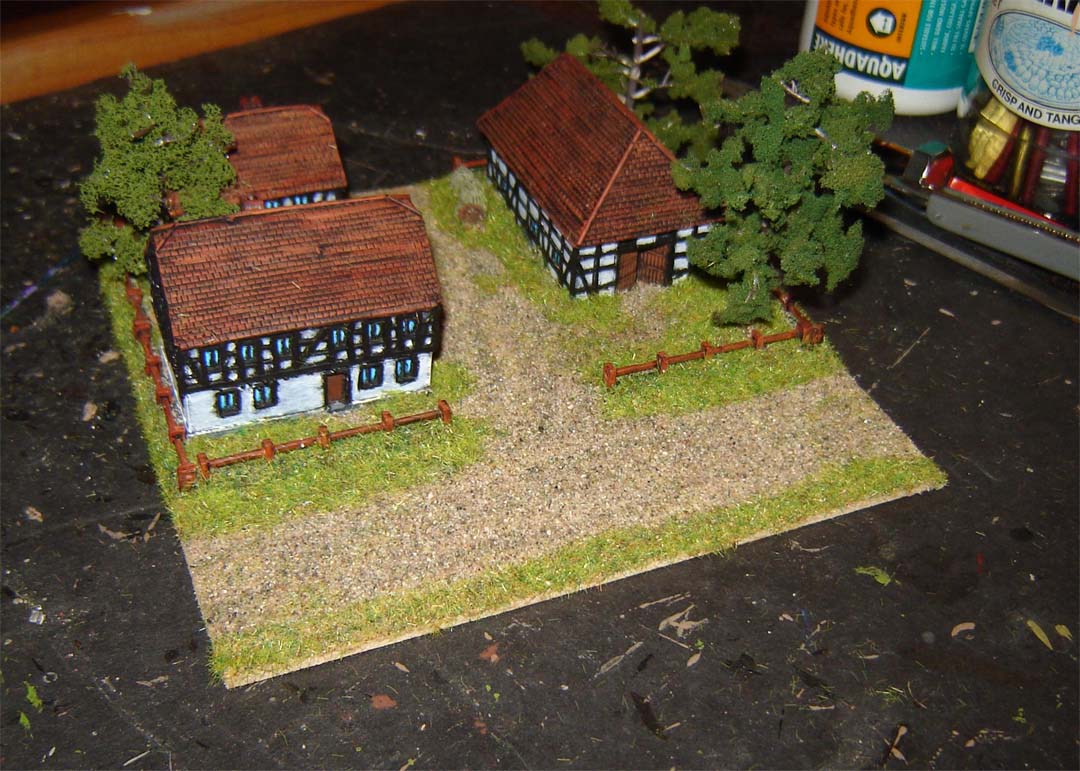How to Paint Buildings
Rex Hurley
Introduction
I chose to write this article as I had some lovely Timecast micro and other larger scale buildings awaiting the paintbrush and realised that regardless of how many of the manufacturers sites you visit that while there are lots of lovely pictures there usually aren’t any 'How to’s', so I decided to put pen to paper.
In this article I outline the steps to take an idea from concept to finish and all the steps are equally relevant regardless of the scale you are in working. I also use Vallejo acrylivcs for all my work but comparable paints such as GW, Cote de Arms should work equally as well.
The Project
For this particular Project I wanted to create a small farmyard to compliment my 6mm Napoleons Battles Project which had a variety of Timecast buildings in it with a road going past that could also be used in other era’s such as WWII and Modern.
To achieve this I began by thinking up a whole lot of ideas and laying them out. When I was satisfied I had selected my models, which included 1 part of 20E/L1 for the workers house, 1 part 20E/L2 for the owners house, the barn 20E/L4, a couple of haystacks 37/001, a couple of wheels from a French Limber set, a set of fences 37/007, a couple of Heki trees and a 150mm x 150mm 2mm MDF base,
Step 1
As with all painting having a well lit comfortable painting area is essential. However a solar powered figure crushing cat isn’t!!

Step 2
Again as with all painting prep is essential. For these buildings some say washing is useful to remove dust, I don’t do that rather I dust the models off by running a large frayed brush over them removing all excess dust from the models in doing so.
Step 3
I then follow this with a good spray of Games Workshop Chaos Black straight from the can. You can of course use Car Primer or other types of spray but I prefer the GW paint as the nozzle is specifically designed with a finer nozzle which creates a better mist and cover than normal car spray cans.

Step 4
Select the colours you want to use then start building up the layers
of colour. Always remember all base coats should be a darker complimentary
colour of the final result and being smaller you have to be bold with
your colour selections to get the highlights visible at gaming distance,
and that the black adds to the depth.
In this case I was looking for a traditional white washed buildings with terracotta/orangey coloured roof tiles, and light reflecting off the windows, so my base colours were:
• For whitewash, 869 Basalt Grey
• For the roof, 818 Red Leather
• For the windows, 841 Andrea Blue
• For the grass base, 850 Medium Olive
• For the haystacks, 921 English Uniform
• For the doors, wheels and fences, 984 Flat Brown
I applied this using one of my favourite gnarly old brushes which is worn down to the nub which is perfect for work like this where you have tight spaces and require a rubbing motion to get the results.

Apply the paint by getting a bit on the end of the brush then rubbing
it on a piece of paper or similar (I use my paint board as you might be
able to tell!) to get slightly more than drybrushing but not too much
then rub it on to the surface of the building letting the natural style
of the paint, the black undercoat and the raised building moulding to
generate the results. Don’t fill in all the gaps let the black come
through a bit and don’t worry about being overly accurate as we
will tidy up any overlap later on in the process.



Step 5
After the base coat is dry use the same technique for the next top coat but apply it to a smaller area than last time allowing the base coat to show on the edges thus giving your model the depth of colour. Remember your top coats need to compliment the colour palette that you started with. In this case my top coats were:
• For whitewash, 70951 White
• For the roof, 70929 Light Brown
• For the windows, 844 Deep Sky Blue
• For the haystacks, 978 Dark Yellow
• For the doors, wheels and fences , a repeat of the 984 Flat Brown


Sometimes with white you may have to do another touch up just to give it some “zing” as I did but that is personal taste as to what you want.
Step 6
Now clean up all the overlaps and edges with the right colours and any trimmings such as the black wooden battens on these buildings, plus any small items such as hinges, door handles, lattice framing, etc.


Step 7
Now you have finished painting your items lay them out on your base board and glue in place. I use PVA for this and leave it overnight.

Step 8
Apply sand or your preferred basing material to the base let dry. For myself I use fine bird cage sand from the petshop which is clean, cheap and easy to use.

Step 9
Apply static grass and hey presto your done!!



And a teaser of other ideas that are possible, only your imagination limits what can be done,
cheers Rex
